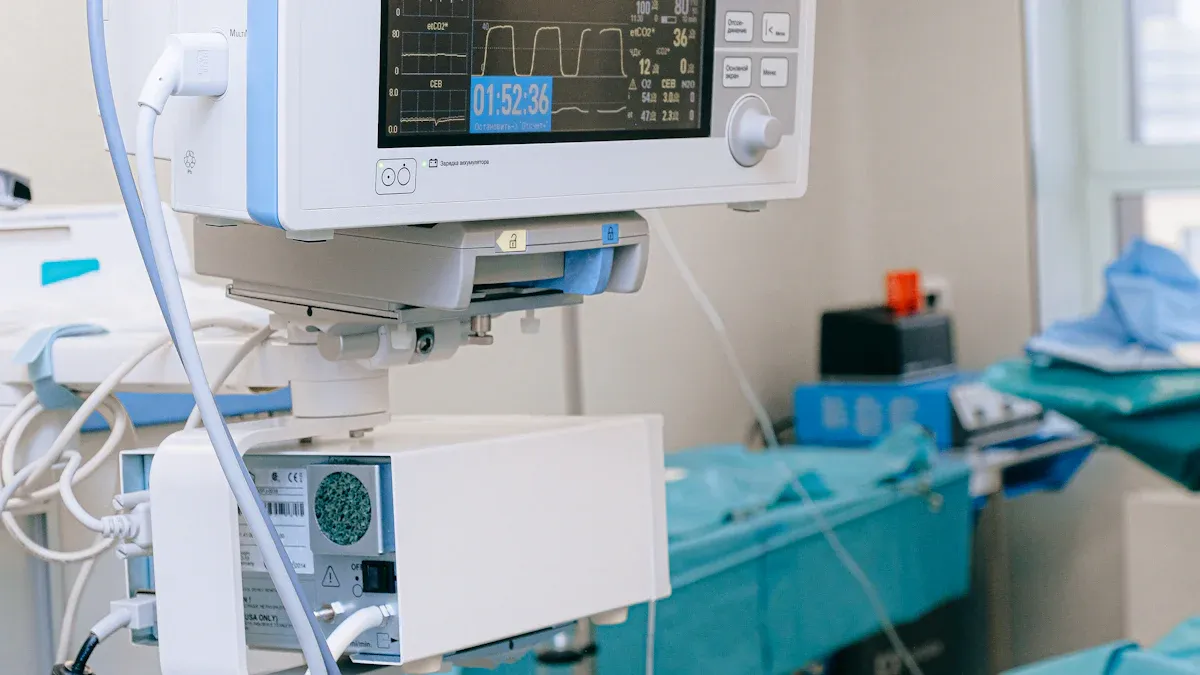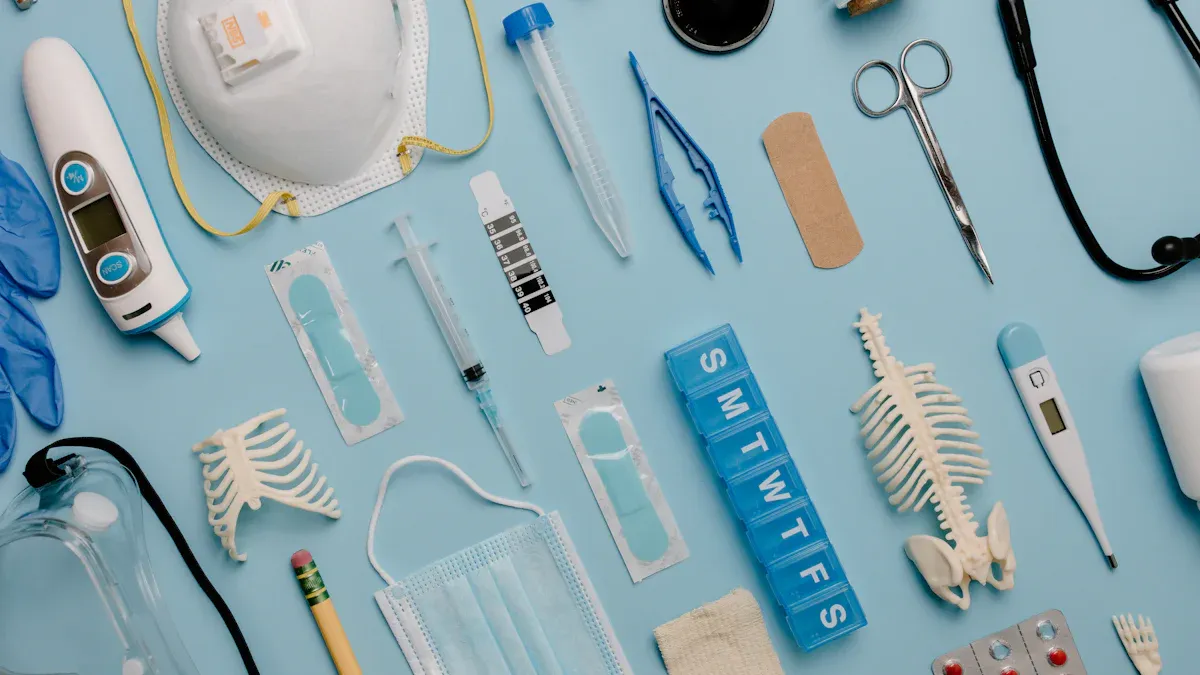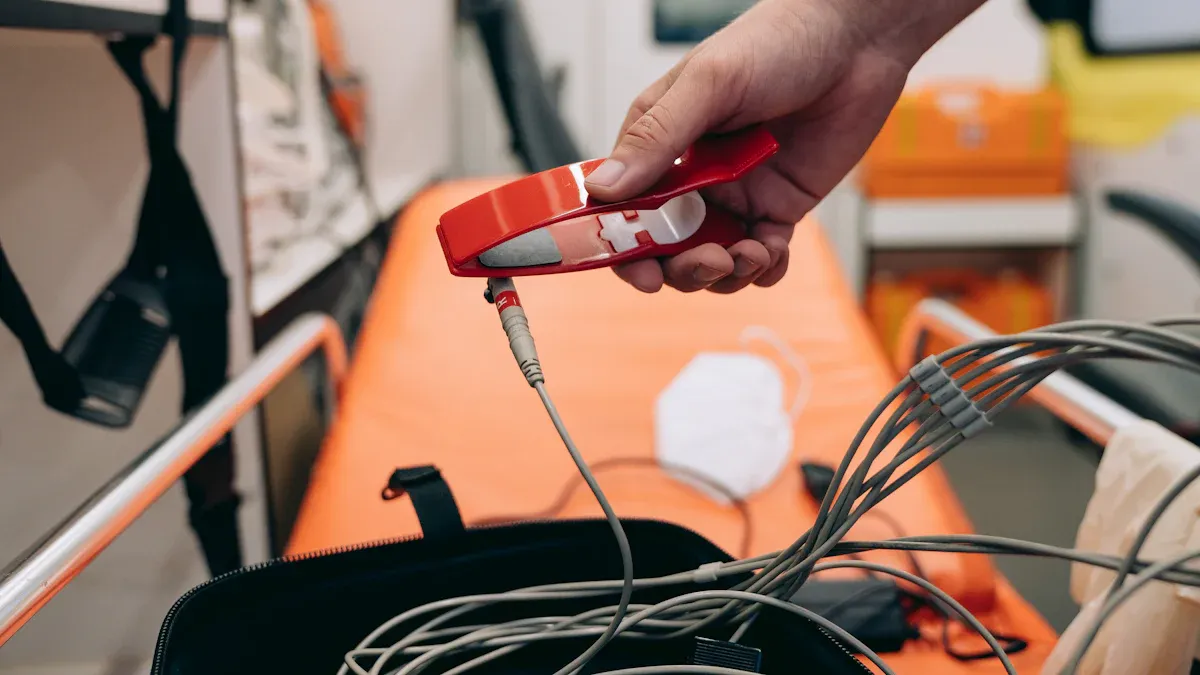How Superelastic Nitinol Tubing is Used in Life-Saving Medical Devices

Superelastic Nitinol tubing, a remarkable material composed of nickel and titanium, exhibits unique properties that revolutionize modern healthcare. Its ability to return to its original shape after deformation ensures reliability in life-saving medical devices. For instance, vascular stents made with Nitinol maintain vessel patency, with studies like ORION demonstrating their flexibility and long-term success. Minimally invasive procedures benefit significantly from this material, reducing recovery times and improving patient outcomes. This innovation has transformed healthcare by enabling precise, durable solutions for complex medical challenges.
Key Takeaways
Superelastic nitinol tubing bends but returns to its original shape. This makes it dependable for medical devices like stents.
Nitinol is safe for the body and lowers the chance of bad reactions. This makes it better for long-term use in patients.
Nitinol tubing is strong and flexible. It can move through tricky body pathways, helping with less invasive surgeries.
Medical devices made with nitinol help patients recover faster. They also improve health results, making nitinol popular in healthcare.
Nitinol does not rust easily, so it lasts a long time. This means fewer replacements and lower healthcare costs.
Unique Properties of Superelastic Nitinol Tubing

Superelasticity and Shape Memory
Superelastic nitinol tubing exhibits extraordinary superelasticity and shape-memory properties, making it indispensable in medical device applications. Its ability to undergo elastic deformation up to 10% strain, compared to only 1% in conventional materials like stainless steel, ensures superior performance in dynamic environments. This unique behavior stems from stress-induced phase changes within the material, allowing nitinol tubing to return to its original shape after deformation.
Devices such as self-expanding stents leverage this shape memory property to adapt to the body's anatomy. For instance, nitinol tubing can be compressed for insertion and then expand precisely to its intended form once deployed. Clinical tests, including cyclic life testing, confirm the reliability of these properties, highlighting their importance in enhancing safety during complex surgical procedures. Additionally, studies emphasize the role of wall thickness and surface finish in optimizing the performance of nitinol tubing, ensuring its durability and effectiveness in critical applications.
Biocompatibility and Corrosion Resistance
Nitinol tubing's biocompatibility ensures seamless integration with biological tissues, reducing the risk of adverse reactions. In vivo studies using swine models demonstrated successful integration into the vascular system within 30 days, with histopathology confirming new tissue growth over the tubing. This compatibility makes nitinol tubing ideal for devices like vascular stents and implants, where long-term interaction with the body is crucial.
The material's corrosion resistance further enhances its safety and longevity. The smooth surface finish of nitinol tubing minimizes the risk of degradation, even in challenging environments like the cardiovascular system. This property ensures that nitinol-based devices maintain their structural integrity over time, providing reliable solutions for patients. These attributes collectively make nitinol tubing a preferred choice for life-saving medical devices.
Flexibility and Durability in Medical Applications
Enhanced flexibility and durability set nitinol tubing apart from traditional materials. Its ability to endure repeated deformation cycles without permanent damage ensures long-term reliability in medical devices. For example, nitinol tubing's flexibility allows it to navigate complex anatomical pathways, making it ideal for minimally invasive procedures involving catheters and guidewires.
Nitinol's durability also contributes to improved patient outcomes. Devices made from nitinol tubing can withstand the mechanical stresses of daily use, reducing the need for frequent replacements. Numerous successful procedures highlight the efficacy of nitinol-based devices, demonstrating their ability to prioritize patient comfort while maintaining high performance. These properties have transformed the medical device industry, enabling innovations that enhance safety and treatment reliability.
Applications of Nitinol Tubing in Medical Devices

Stents and Vascular Implants
Nitinol tubing has revolutionized the design and functionality of stents and vascular implants, particularly in cardiovascular treatments. Its superelasticity and shape-memory properties allow self-expanding stents to adapt seamlessly to the body's anatomy. These stents can be compressed for insertion and then expand to their intended size once deployed, ensuring optimal blood flow in narrowed or blocked vessels. This adaptability reduces the risk of complications and enhances long-term outcomes for patients.
Studies highlight the importance of material quality in these applications. Improved manufacturing techniques and enhanced material cleanliness significantly increase the fatigue life of nitinol tubing. High-cycle fatigue strain limits, ranging from 0.4% to 0.8%, ensure the durability of stents in high-demand environments like the cardiovascular system. Patients with nitinol-based implants experience a 30% lower rejection rate compared to traditional metals, further emphasizing the material's biocompatibility and reliability.
Performance Highlights:
The Silverway guidewire achieved a vessel crossing success rate of 98% in patients.
Catheters were successfully delivered in 92% of cases.
No clinically relevant complications were reported after the use of the guidewire.
These statistics underscore the effectiveness of nitinol tubing in life-saving medical devices, particularly in cardiovascular treatments.
Catheters and Guidewires
The flexibility and durability of nitinol tubing make it an ideal material for catheters and guidewires. These devices navigate complex anatomical pathways during minimally invasive procedures, such as angioplasty or cardiac catheterization. Nitinol's ability to endure repeated deformation cycles without permanent damage ensures reliable performance in these critical applications.
Guidewires, often made from nitinol tubing, provide exceptional maneuverability and precision. Their superelasticity allows them to bend and flex without kinking, enabling physicians to access hard-to-reach areas of the body. Catheters, on the other hand, benefit from nitinol's corrosion resistance and biocompatibility, ensuring safe and effective delivery of treatments.
The combination of these properties has transformed the field of minimally invasive surgery. Patients experience shorter recovery times and fewer complications, while healthcare providers benefit from the reliability and longevity of nitinol-based devices.
Orthopedic Devices and Bone Fixation
In orthopedic applications, nitinol tubing plays a crucial role in bone fixation systems and implants. Its shape-memory property allows fixation devices to conform to the natural contours of bones, providing a secure and stable fit. This adaptability enhances the healing process and reduces the risk of implant failure.
Quantitative studies demonstrate the advantages of nitinol in orthopedic devices:
Evidence Type | Findings | Comparison |
|---|---|---|
Stiffness-matched NiTi fixation plates | Enhanced bone healing and better load transfer | Compared to bulk Ti64 in control group |
These findings highlight the superior performance of nitinol-based fixation systems over traditional materials. The material's flexibility and durability also enable it to withstand the mechanical stresses of daily activities, ensuring long-term reliability.
Orthopedic surgeons increasingly rely on nitinol tubing for its ability to improve patient outcomes. By facilitating better load distribution and promoting natural bone healing, nitinol-based devices have become a cornerstone of modern orthopedic care.
Surgical Tools and Other Emerging Applications
Nitinol tubing has become a cornerstone in the development of advanced surgical tools, offering unmatched precision and adaptability. Its unique properties, including superelasticity, shape memory, and biocompatibility, make it an ideal material for instruments used in minimally invasive procedures. Surgeons rely on nitinol-based tools to perform complex operations with greater accuracy and reduced patient trauma.
Enhanced Performance in Surgical Tools
The flexibility and strength of nitinol tubing allow surgical instruments to navigate intricate anatomical structures. For instance, laparoscopic tools made from nitinol tubing can bend and flex without losing their structural integrity. This capability ensures that surgeons can access hard-to-reach areas while maintaining control and precision. Additionally, nitinol's durability ensures that these tools withstand repeated use without compromising performance.
Robotic-assisted surgeries have further expanded the role of nitinol tubing. Instruments integrated with robotics benefit from nitinol's ability to maintain consistent performance under dynamic conditions. This integration enhances surgical outcomes by reducing complications and improving procedural accuracy.
Emerging Applications and Trends
The versatility of nitinol tubing extends beyond traditional surgical tools. Emerging applications leverage its properties to address evolving healthcare needs. Recent trends highlight its growing importance:
Trend Description | Implication for Nitinol Tubing |
|---|---|
Increasing demand for minimally invasive surgeries | Nitinol's flexibility and strength make it ideal for laparoscopic and robotic-assisted surgeries, enhancing surgical outcomes. |
Integration of advanced technologies (3D printing and robotics) | Customization of Nitinol tools improves surgical results and accuracy, reducing complications. |
Focus on sustainability | Eco-friendly practices in Nitinol production align with consumer demand for sustainable healthcare solutions. |
Growth in emerging economies | Rising healthcare expenditures in regions like Asia-Pacific drive the adoption of Nitinol instruments. |
These trends underscore the transformative potential of nitinol tubing in modern medicine. For example, 3D printing technology enables the creation of customized nitinol instruments tailored to individual patient needs. This level of personalization enhances the effectiveness of surgical interventions while minimizing risks.
Future Potential in Healthcare
The adaptability of nitinol tubing positions it as a key material for future innovations. Researchers are exploring its use in next-generation surgical tools, including micro-scale instruments for delicate procedures. Its compatibility with advanced manufacturing techniques, such as additive manufacturing, opens new possibilities for creating intricate designs that were previously unattainable.
Moreover, the focus on sustainability in healthcare aligns with the eco-friendly production of nitinol. Manufacturers are adopting greener practices to meet the growing demand for sustainable medical solutions. This shift not only benefits the environment but also strengthens the appeal of nitinol-based devices in global markets.
Benefits of Using Nitinol Tubing in Healthcare
Enabling Minimally Invasive Procedures
Nitinol tubing has become a cornerstone in minimally invasive procedures, offering unmatched performance and safety. Its superelasticity allows medical devices to navigate complex anatomical pathways with ease, reducing the need for large incisions. This property minimizes trauma to surrounding tissues, leading to smaller scars and faster healing. The material's biocompatibility further ensures safer long-term use by reducing risks such as inflammation or thrombosis.
The flexibility of nitinol tubing enhances its ability to adapt to the body's natural contours, making it ideal for cardiovascular procedures. For example, self-expanding stents made from nitinol tubing maintain vessel patency while minimizing complications. A study highlighted that nitinol's corrosion resistance prevents metal degradation, ensuring the durability of implanted devices. These attributes collectively make nitinol tubing indispensable in modern healthcare.
Property | Description |
|---|---|
Flexibility | Nitinol tubing offers unmatched flexibility, allowing devices to navigate complex anatomical pathways with ease. |
Durability | The material's durability ensures long-term effectiveness in medical applications. |
Biocompatibility | Nitinol's biocompatibility minimizes adverse reactions, ensuring safer long-term use in patients. |
Superelasticity | This property allows for less invasive procedures, leading to faster recovery times and improved patient outcomes. |
Improved Patient Outcomes and Recovery Times
The use of nitinol tubing in medical devices has significantly improved patient outcomes. Its shape-memory property ensures precise deployment of devices, reducing procedural errors. Patients benefit from shorter hospital stays and faster recoveries due to the minimally invasive nature of nitinol-based treatments. Clinical studies have shown that nitinol stents improve success rates in cardiovascular procedures, further enhancing patient outcomes.
Nitinol's biocompatibility plays a crucial role in reducing adverse reactions, such as tissue rejection or inflammation. This compatibility promotes better integration with human tissue, ensuring long-term effectiveness. Patients undergoing procedures with nitinol-based devices report less postoperative pain and quicker healing, making it a preferred material in healthcare.
Improvement Type | Description |
|---|---|
Recovery Times | Patients experience shorter hospital stays and faster recoveries when using nitinol-based devices. |
Procedural Success Rates | Clinical studies show improved success rates in cardiovascular treatments with nitinol stents. |
Integration with Human Tissue | Nitinol's biocompatibility reduces the risk of adverse reactions, enhancing overall patient outcomes. |
Cost-Effectiveness and Long-Term Durability
Nitinol tubing offers a cost-effective solution for healthcare providers. Its durability reduces the need for frequent replacements, lowering long-term costs. Devices made from nitinol tubing withstand repeated mechanical stresses, ensuring consistent performance over time. This reliability translates to fewer complications and reduced healthcare expenses for patients.
The material's corrosion resistance further enhances its longevity, making it suitable for long-term implantation. By minimizing the risk of device failure, nitinol tubing contributes to improved patient satisfaction and reduced follow-up procedures. Its ability to combine cost-effectiveness with high performance underscores its value in modern medical devices.
Tip: The combination of durability, biocompatibility, and flexibility makes nitinol tubing a sustainable choice for healthcare innovations.
Future Trends and Innovations in Nitinol Tubing
Integration with Robotics in Surgery
The integration of nitinol tubing with robotic-assisted surgery is revolutionizing the medical field. Nitinol's unique properties, such as shape memory and superelasticity, make it an ideal material for robotic instruments. These characteristics allow surgical tools to maintain their shape and withstand significant stress during complex procedures. Robotic systems equipped with nitinol-based instruments can perform precise movements, enhancing surgical accuracy and reducing patient trauma.
Forecasts and innovation indices suggest that this synergy will significantly improve surgical outcomes. The ability of nitinol tubing to adapt to intricate anatomical structures aligns perfectly with the precision required in robotic surgery. As a result, surgeons can access hard-to-reach areas with minimal invasiveness, leading to faster recovery times and fewer complications. This advancement underscores the transformative potential of nitinol in modern healthcare.
AI-Driven Design and Customization
Artificial intelligence is reshaping the design and functionality of nitinol-based medical devices. AI-driven tools are enabling the creation of highly customized surgical instruments tailored to individual patient needs. This level of personalization enhances the performance and reliability of nitinol tubing in advanced surgical applications.
AI integration is influencing the development of nitinol surgical instruments.
The creation of smart instruments enhances customization capabilities.
AI-powered diagnostic tools and surgical robots are expanding applications for nitinol instruments.
These innovations are not only improving the precision of medical devices but also broadening their scope of use. For instance, AI algorithms can analyze patient-specific data to optimize the design of nitinol stents or guidewires, ensuring better outcomes. This approach represents a significant leap forward in personalized medicine.
Advances in Material Science and Manufacturing
Recent advancements in material science are enhancing the production and performance of nitinol tubing. Additive manufacturing techniques, such as 3D printing, are enabling the creation of intricate designs that were previously unattainable. These methods improve production efficiency while maintaining the high-quality standards required for medical applications.
Innovations in surface treatments, like electropolishing, enhance corrosion resistance and biocompatibility.
Continuous monitoring of gas atmospheres during processing improves mechanical properties and reduces defects.
Enhanced heat treatment methods improve precision in shape-setting processes for catheter components.
These advancements are addressing long-standing challenges in the manufacturing of nitinol tubing. Improved surface treatments ensure that devices remain safe and effective over extended periods, while precise heat treatments enhance the reliability of shape-memory properties. Together, these innovations are paving the way for the next generation of nitinol-based medical devices.
Superelastic Nitinol tubing has redefined the landscape of healthcare by combining unique properties like shape memory, superelasticity, and biocompatibility. These attributes have enabled its extensive use in medical devices, from vascular stents to orthopedic implants. Studies presented at the Shape Memory and Superelastic Technologies Conference, such as "Cumulative Nitinol Fatigue with Statistical Evaluation" and "Effects of Tube Processing on the Fatigue Life of Nitinol," highlight its reliability and adaptability in critical applications.
Nitinol's transformative role in advancing life-saving medical technology cannot be overstated. Its integration into minimally invasive procedures has improved patient outcomes by reducing recovery times and enhancing procedural success rates. As material science and AI-driven design continue to evolve, nitinol holds immense potential to revolutionize healthcare further. Future innovations will likely expand its applications, ensuring that this remarkable material remains at the forefront of medical advancements.
FAQ
What makes nitinol unique compared to other materials in medical devices?
Nitinol stands out due to its superelasticity, shape memory, and biocompatibility. These properties allow it to adapt to the human body, making it ideal for minimally invasive procedures and long-term implants.
How does nitinol improve patient outcomes?
Nitinol enables minimally invasive procedures, reducing recovery times and complications. Its flexibility and durability ensure reliable device performance, leading to better procedural success rates and enhanced patient satisfaction.
Is nitinol safe for long-term use in the body?
Yes, nitinol is highly biocompatible and corrosion-resistant. These attributes minimize adverse reactions and ensure the material's safety and effectiveness for extended periods in medical applications.
What are the primary medical applications of nitinol?
Nitinol is widely used in stents, guidewires, catheters, and orthopedic implants. Its unique properties also make it suitable for advanced surgical tools and emerging technologies like robotic-assisted surgeries.
How does nitinol contribute to cost-effectiveness in healthcare?
Nitinol's durability reduces the need for frequent replacements, lowering long-term costs. Its reliability minimizes complications, saving healthcare providers and patients additional expenses.
See Also
Nitinol Tubing's Impact on the Future of Healthcare Devices
Understanding Nitinol Tubing Uses in Modern Medical Equipment
The Importance of Nitinol Tubing in Medical Innovations
Nitinol Tubing's Contribution to Cutting-Edge Medical Technology

